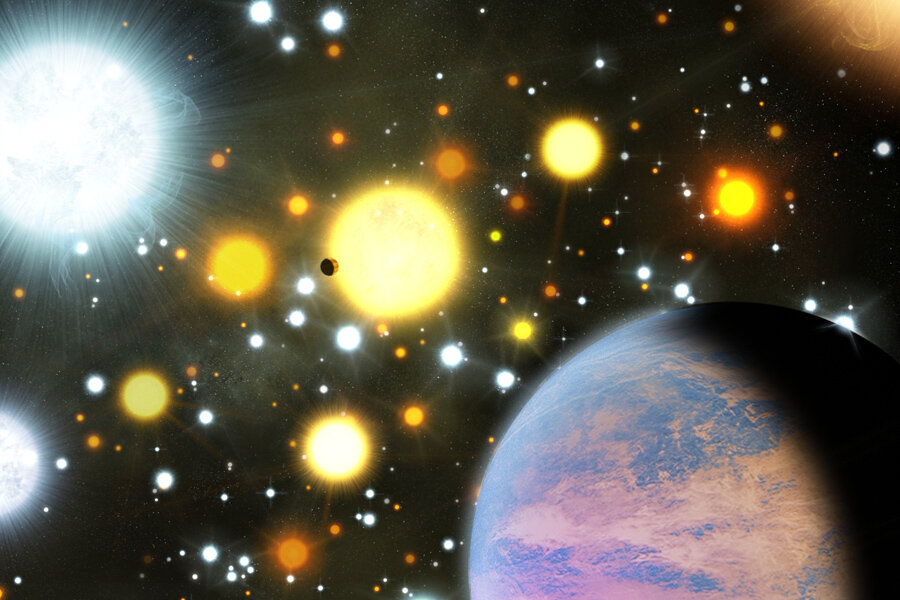Galactic miracle babies? Smallish planets survived birth in stellar maelstrom.
Loading...
In a cosmic episode of "Survivor," astronomers say they have found two mini-Neptunes, each orbiting its own star in a stellar cluster that would have been a very rough neighborhood when the planets were born.
The discovery addresses a longstanding question: "What is the effect of the stellar environment on the process of planet formation?" writes astronomer Soren Meibom, who led the team announcing the find, in an e-mail.
The find suggests that planet formation is a more robust, insistent process than previously thought. Planets appear to form at about the same rate in dense, open clusters as they do in far more benign ones, writes Dr. Meibom, a researcher at the Harvard-Smithsonian Center for Astrophysics in Cambridge, Mass. The team is publishing a formal report of its results in Thursday's issue of the journal Nature.
Four other planets have been found previously orbiting stars in clusters, but they have been Jupiter's size or larger. These two new planets represent the smallest yet found in a once-dense cluster.
These are not the kind of planets that would set an astrobiologist to tingling with delight. Each planet is about three times the size of Earth. Each orbits a 1-billion-year-old, sun-like star every 16.8 days for one planet and 15.7 days for the other. These planets would be baking.
Even so, they represent the galaxy's miracle babies.
They appeared in data gathered by NASA's ailing Kepler mission. Kepler is a craft designed to orbit the sun at Earth's distance and stare at one patch of sky continuously, taking in views of some 170,000 stars. The craft detects the slight wink a planet imparts to starlight as it transits in front of its host star. The goal is to develop a planetary census, with a particular eye to estimating the number of Earth-mass planets orbiting sun-like stars at earth-like distances.
The two new planets are the first to be found orbiting stars in a cluster in Kepler's data.
The stars, Kepler 66 and 67, appear in an open cluster dubbed NGC6811, some 3,600 light-years away in the constellation Cygnus. The cluster contains at least 450 stars. The stars are loosely bound by their collective gravity and so disperse over time, hence the moniker "open." [Editor's note: The original version of this story incorrectly identified how many stars the cluster contains.]
Nearly all stars form in open clusters as they condense out of common clouds of gas and dust, researchers say. Most of these open clusters are relatively sparsely populated – perhaps forming fewer than 100 stars for each cubic parsec of space – a cube roughly 3 light-years on a side. Even that is overpopulation by the standard's of today's sun. Its closest neighbor is Proxima Centauri, about 4 light-years away.
These less-dense clusters, such as the one that gave birth to the sun, are relatively peaceful planetary nurseries and tend to disperse quickly.
But some open clusters start out with between 1,000 and 10,000 stars per cubic parsec. Based on several factors, including the number and masses of the remaining stars in the cluster and the cluster's age, the team estimates that NGC6811 initially held about 13,000 stars per cubic parsec. By the time planets Kepler 66c and Kepler 67c formed, the number would have dwindled to 6,000 stars per cubic parsec.
Many of these stars would have been brutes, with several hosting more than 20 times the sun's mass, and more than 100 or so ranging from 3 to 20 times the sun's mass, the scientists calculate. Any star above about 10 solar masses would have ended its relatively short life in a cataclysmic explosion known as a supernova, which blasts vast amounts of matter into interstellar space.
Even before such big bangs, however, stars so tightly packed would have been emitting enormous amounts of ultraviolet radiation, spawning large flares or shedding vast amounts of mass as the stellar equivalent of the sun's coronal-mass ejections. Even smaller stars such as red dwarfs can be hotheads with very active surfaces. And the stars all move within the cluster, setting up conditions ripe for gravitational disturbances as they move past other stars.
Any one of these processes could be expected to disrupt the seemingly fragile disks of dust and gas that surround new stars and form planets – even on clumps within clouds that would form news stars. Taken together, these influences might seem to be virtual show-stoppers for planet formation.
And yet, these two planets, not much larger than Earth, formed and survived.
The team used theoretical models to try to get a sense for what these planets might be like. Given their sizes and estimated masses, they likely contain large amounts of ices, at least on their space-facing hemispheres, and assuming no atmospheres to redistribute heat planet-wide. Besides, the team argues, if the planets were rocky, they would have masses closer to that of Saturn – some 82 to 100 Earth masses. The team estimates the masses for each of these two planets as less than 20 Earth masses.
The find is whetting astronomers' appetites for planet-hunting within other aged open clusters. Two of three other clusters in Kepler's view are older than NGC6811, including one between 7 billion and 9 billion years old, notes San Diego State University astronomer William Welsh.
"Even if a cluster has a dense, violent history, it doesn't seem to affect planet formation," he writes in an e-mail.
In a commentary in Nature tied to the report of these two new planets, he said, "It will be truly fascinating to learn the planet-occurrence rate in this cluster."





